- Messages
- 224
- Reactions
- 72
Follow along with the video below to see how to install our site as a web app on your home screen.
Note: This feature may not be available in some browsers.
numbers matching 1891 Argentine Mauser, C block but with a scrubbed crest as is common. Attached to it is an appropriate 1891 brass handled bayonet.
View attachment 360836
Nice one. My own M1891 is a "C"-series too....scrubbed, like yours, but with the short hand-guard and the lack of bolt sleeve flanges and brass-tipped cleaning rod as were standard early in Leowe's early part of the contract.
Best,
Gunnar

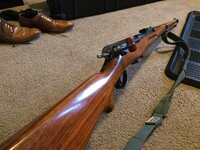
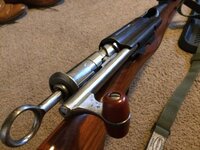
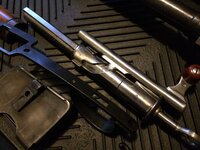
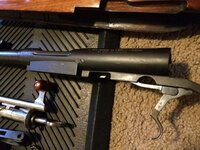

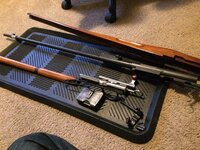
Gun show find. Prepare yourselves...
Sig-manufactured, year 1900 (I believe) Swiss Model 1896/11. If it looks good in the pictures, believe me: it looks better in the real world. The condition this is in is unbelievable. It's got a P-mark on it, indicating it was taken into private ownership by whoever it was issued to, and they took very good care of it. The stock has just a handful of little dings, looks like it was refinished professionally, and the condition of the metal is almost pristine, outside of the cocking ring having some wear. I couldn't walk away from it. Just couldn't.
Very nice Mark I, I have one that still has the original Mark I parts, not as pretty as yours thoughVirtually all the Mark 1's had their cut-off spindle assemblies changed back into standard '03 types from the type compatible with the Pedersen Device so any of the minuscule number of Devices still laying around out there won't fit even in an ex-Mark 1 receiver but I still enjoy the Mark 1's as the history surrounding them is interesting. Only a few of the once circa 65,000 Pedersen Devices produced still exist as far as I know.
Apparently, however, the operational security surrounding the supposedly top-secret Pedersen Device project (as the "Pistol, Caliber .30, Model of 1918") wasn't the best evidently since Army G-2, going into the factory of Rheinische Westfallian Sprengstoff A.G. in Nurnberg, Germany after WWII, found a Pedersen Device with M1903 rifle in among the firm's exhibits and the tag accompanying the items indicated it had been on the grounds since 1920!
The professional and personal history of John Pedersen is also fascinating......developer of several pump-action .22 rifles, nearly one to have his company become a manufacturer of the M1 Carbine, and developer of the world's most notable working delayed-blowback, toggle-lock, rifle.....a variant of which was both shown-off, by John Pedersen himself, and copied by the Japanese.
An engineer for Tokyo Gas & Electric, Masaya Kawamura, (who, incidentally, helped bring together the barrel and bayonet housing elements of the Type 44 Cavalry Carbine) worked out a "kick-up cam" that increased the amount of time the Pedersen Rifle's toggle-lock bolt remained close and thereby did away with the need for having each cartridge for the gun covered in paraffin wax to aid in extraction.
Neither the Pedersen Rifle, its later Tokyo Artillery Arsenal clone, nor the TG&E version worked up by Dr. Kawamura, were ever officially adopted although a few of the Tokyo clones WERE found in a cave on Okinawa by US forces in Summer 1945 so one of Pedersen's guns may well have FINALLY been fired in anger.........although, ironically, at his countrymen.
Gunnar
Virtually all the Mark 1's had their cut-off spindle assemblies changed back into standard '03 types from the type compatible with the Pedersen Device so any of the minuscule number of Devices still laying around out there won't fit even in an ex-Mark 1 receiver but I still enjoy the Mark 1's as the history surrounding them is interesting. Only a few of the once circa 65,000 Pedersen Devices produced still exist as far as I know.
Apparently, however, the operational security surrounding the supposedly top-secret Pedersen Device project (as the "Pistol, Caliber .30, Model of 1918") wasn't the best evidently since Army G-2, going into the factory of Rheinische Westfallian Sprengstoff A.G. in Nurnberg, Germany after WWII, found a Pedersen Device with M1903 rifle in among the firm's exhibits and the tag accompanying the items indicated it had been on the grounds since 1920!
The professional and personal history of John Pedersen is also fascinating......developer of several pump-action .22 rifles, nearly one to have his company become a manufacturer of the M1 Carbine, and developer of the world's most notable working delayed-blowback, toggle-lock, rifle.....a variant of which was both shown-off, by John Pedersen himself, and copied by the Japanese.
An engineer for Tokyo Gas & Electric, Masaya Kawamura, (who, incidentally, helped bring together the barrel and bayonet housing elements of the Type 44 Cavalry Carbine) worked out a "kick-up cam" that increased the amount of time the Pedersen Rifle's toggle-lock bolt remained close and thereby did away with the need for having each cartridge for the gun covered in paraffin wax to aid in extraction.
Neither the Pedersen Rifle, its later Tokyo Artillery Arsenal clone, nor the TG&E version worked up by Dr. Kawamura, were ever officially adopted although a few of the Tokyo clones WERE found in a cave on Okinawa by US forces in Summer 1945 so one of Pedersen's guns may well have FINALLY been fired in anger.........although, ironically, at his countrymen.
Gunnar